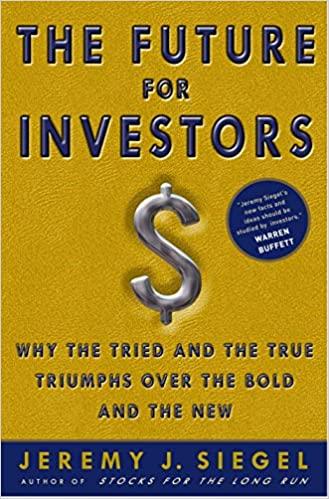Question
1. The term leaving money on the table refers to the situation where an investment banking house makes a very low bid for the right
1. The term leaving money on the table refers to the situation where an investment banking house makes a very low bid for the right to underwrite a firms new stock offering. The banker is, in effect, buying the job with the low bid and thus not getting all the money his firm would normally earn on the job.
a. True
b. False
2. Which of the following statements is most CORRECT?
a. The smaller the synergistic benefits of a particular merger, the greater the scope for striking a bargain in negotiations, and the higher the probability that the merger will be completed.
b. Since mergers are frequently financed by debt rather than equity, a lower cost of debt or a greater debt capacity are rarely relevant considerations when considering a merger.
c. Managers who purchase other firms often assert that the new combined firm will enjoy benefits from diversification, including more stable earnings. However, since shareholders are free to diversify their own holdings, and at whats probably a lower cost, diversification benefits is generally not a valid motive for a publicly held firm.
d. Operating economies are never a motive for mergers.
e. Tax considerations often play a part in mergers. If one firm has excess cash, purchasing another firm exposes the purchasing firm to additional taxes. Thus, firms with excess cash rarely undertake mergers.
3.
Suppose Stanleys Office Supply purchases 50,000 boxes of pens every year. Ordering costs are $100 per order and carrying costs are $0.40 per box. Moreover, management has determined that the EOQ is 5,000 boxes. The vendor now offers a quantity discount of $0.20 per box if the company buys pens in order sizes of 10,000 boxes. Determine the before-tax benefit or loss of accepting the quantity discount. (Assume the carrying cost remains at $0.40 per box whether or not the discount is taken.)
a. $1,000 loss
b. $1,000 benefit
c. $ 500 loss
d. $ 500 benefit
e. $ 0 (The change would not affect profits.)
4.A firm forecasts the euro's value as follows for the next year:
|
| ||
| -2 % | 10% | ||
| 3% | 50% | ||
| 6% | 40% |
The annual interest rate on the euro is 7%. The expected value of the effective financing rate from a U.S. firm's perspective is about:
a. 8.436%.
b. 10.959%.
c. 11.112%.
d. 11.541%
Step by Step Solution
There are 3 Steps involved in it
Step: 1

Get Instant Access to Expert-Tailored Solutions
See step-by-step solutions with expert insights and AI powered tools for academic success
Step: 2

Step: 3

Ace Your Homework with AI
Get the answers you need in no time with our AI-driven, step-by-step assistance
Get Started


